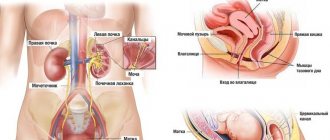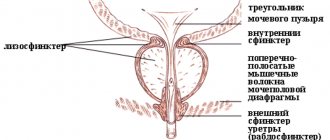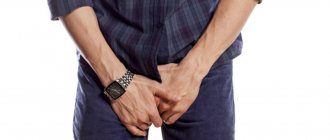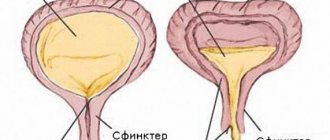Acute urinary retention (ICD-10 code - R33) is an emergency condition characterized by the inability to drain urine from a full bladder. This disorder is a companion to a variety of diseases. This condition was included in the international register a long time ago, but not everything is known about it to this day. Acute urinary retention is diagnosed when such a disorder develops suddenly and has not previously been observed in the patient. More often, men suffer from the disorder, which is due to the anatomical structure of the urinary canal. The development of this disorder requires immediate medical attention, as there is a high risk of bladder rupture, kidney damage and other equally dangerous complications.
The reasons for the development of this condition can differ significantly between men and women. Representatives of the fair sex are less likely to encounter this problem. Most often, a violation of the outflow of urine in women is associated with tumor formations in the genital organs, which mechanically compress the urethra, making it difficult to remove fluid. In addition, a similar pathological condition can occur during pregnancy, as well as when the bladder prolapses. There are extremely many factors that can cause acute urinary retention in men. The most common causes of pathology include:
- disturbances in the functioning of the central nervous system;
- prostate adenoma;
- urolithiasis;
- sclerosis of the bladder neck;
- tumor formations;
- blood clots;
- severe intoxication;
- severe stress;
- acute prostatitis.
Among other things, impaired urine outflow can be the result of existing genitourinary infections. In some cases, such a pathological condition develops as a complication of previously performed surgical interventions on the rectum and organs located in the pelvis. In male children, the most common cause of acute urination disorders is phimosis, that is, narrowing of the flesh. In girls, blockage of fluid outflow from the bladder is extremely rare. In most cases, they occur against the background of systemic diseases of internal organs. The international classification does not take into account the reasons for the development of such pathology in representatives of both sexes.
Violation of urine drainage from the bladder, as a rule, is manifested by very severe symptoms that cannot be ignored. The main sign of the disorder is severe pain. In men, unpleasant sensations can radiate to the penis. In addition, there is a constant urge to urinate, but it is not possible to empty the bladder. Unsuccessful attempts lead to increased pain. Characteristic signs of the development of acute urinary retention may include:
- growing anxiety;
- bloating;
- peritoneal irritation;
- decreased appetite;
- defecation disorder;
- vomiting and nausea;
- severe weakness;
- insomnia;
- dizziness;
- flatulence;
- increase in body temperature.
In some cases, there is pain in the lower back. This indicates a malfunction of the kidneys due to the inability to remove accumulated urine from them. A rapid increase in the intensity of symptomatic manifestations, as a rule, forces the patient to call emergency doctors.
You cannot take measures on your own to improve the outflow of urine from the bladder, as this can aggravate the situation. For example, with strong pressure on the abdomen, rupture of the organ wall is possible. Health workers should take measures aimed at eliminating acute urine retention. Emergency doctors are responsible for making a diagnosis and providing primary care. Considering that a full bladder may burst when transported to the hospital, procedures to remove fluid are carried out at the patient’s home. Catheterization is usually performed to remove urine from the bladder. This medical procedure involves inserting a very small diameter silicone tube into the urethra.
The catheter allows you to relieve muscle spasm, and also pushes the walls of the natural opening so that urine can be discharged into the urinal. In rare cases, when there are contraindications for catheterization at home, the patient is taken to the surgical department, where accumulated urine is removed through a tube inserted into the bladder through the abdominal wall. This minimally invasive operation is usually performed under a general commissar.
The installed tube is not removed until the root cause of the problem is identified and corrected. If the boat needs to be installed for a long time to prevent infection, the bladder is washed with special antiseptic solutions in the hospital. In some cases, general-spectrum oral antibiotics may be recommended.
After eliminating urine from a full bladder and taking measures to prevent complications from developing, doctors conduct a comprehensive examination to determine the main cause of the problem. The main therapy is aimed at eliminating the identified disease. The favorable outcome depends on the severity and characteristics of the course of the existing primary pathology.
Disease code ICD10 is an urgent process, with characteristic blockage of urine output from an excessively filled bladder. Such discomfort manifests itself in various diseases. The international classification of this pathology has its own code No. 33.
Urinary retention according to ICD 10 is detected during diagnosis in a patient who has not previously experienced such urinary disorders. Features of the anatomical structure of the male urethra explain the frequent manifestation of the disease in the male half. With this classifier No. 33, urgent medical attention is needed to prevent bladder rupture, kidney injury, and the manifestation of other rather dangerous pathologies.
Description
Urinary retention.
A pathological condition characterized by disruption or inability to empty the bladder normally. Symptoms are pain in the pubic region and lower abdomen, a very strong persistent urge to urinate and the resulting psychomotor agitation of the patient, a noticeable weakening of urine output or its absence. Diagnosis is based on a survey of the patient, the results of a physical examination, and ultrasound research methods are used to determine the causes of the condition. Treatment is catheterization or cystostomy to ensure urine outflow, elimination of etiological factors of ischuria.
R33 Urinary retention
Enuresis code according to ICD 10 in children
Enuresis is involuntary urination during sleep. In medical practice, the term “enuresis” usually means involuntary urination during sleep more than once a month in girls over 5 years old and in boys over 6 years old. Frequency : 40% in children aged 3 years, 10% in children aged 6 years, 3% in children aged 12 years and 1% in children aged 18 years.
Etiology • Primary enuresis. In healthy children, by the age of 1.5–2 years, a conditioned reflex connection is formed: the urge to urinate leads to awakening.
If the formation of this connection is delayed, they speak of primary enuresis •• Enuresis is usually not associated with mental, neurological and anatomical disorders •• One of the causes of enuresis is considered to be an insufficient level of physiological maturity •• Insufficient bladder capacity (usually functional) •• Psychological factors •• It is assumed that enuresis is associated with a violation of the ADH secretion cycle; in children suffering from enuresis, morning vasopressin levels are reduced •• One of the possible causes is sleep disorder • Secondary enuresis. Secondary enuresis is caused by a violation of an already formed conditioned reflex •• Somatic diseases: diabetes, urinary tract infections •• Stressful situation •• Organic and functional diseases of the urinary system: obstructive or neurogenic bladder dysfunction, pseudoenuresis - paradoxical ischuria during sleep.
Genetic aspects . Enuresis runs in families and is often combined with mental disorders. Nocturnal enuresis, type 1 (*600631, 13q13–q14.3, ENUR1 gene, Â), nocturnal enuresis, type 2 (*600808, 12q13–q21, ENUR2 gene, Â).
Risk factors • Heredity •• If one of the parents suffered from enuresis, the incidence of the disease in the child is 44% •• If both parents suffered from enuresis, the incidence is 77% • Children from the first birth are more likely to suffer.
Laboratory studies of OAM: with primary enuresis, there are no or minimal changes, in patients with secondary enuresis, when a secondary infection is added, characteristic changes appear.
Instrumental studies • Determination of the size of the bladder: the child holds urine until a constant urge to urinate appears, then the volume of urine excreted is measured • Uroflowmetry • Ultrasound of the kidneys and urinary tract before and after urination • Cystoscopy - according to indications • Excretory urography - according to indications • X-ray of the spine - according to indications for differential diagnosis • Retrograde cystometry and urethroprofilometry - according to indications for differential diagnosis.
Differential diagnosis • Malformations of the urinary tract (for example, bladder outlet obstruction - posterior urethral valve), caudal parts of the spine (spina bifida, myelodysplasia - neurogenic bladder dysfunction) • Injuries and diseases of the urinary tract or spinal cord • Malformations or tumors of the lumbosacral spinal cord brain • Tumors of the pelvic organs • Diabetes insipidus • Diabetes • Tubulopathies • Sickle cell anemia • Chronic constipation.
Treatment • Motivational treatment •• Reward for “dry” nights is desirable •• Do not punish the child for “wet” nights •• Stop taking fluids 2 hours before bedtime • Use specialized alarm clocks. Complete cure occurs in 70% of cases.
The alarm clock beeps when the first drops of urine are released - a conditional reflex connection is formed, the child begins to wake up with the urge to urinate. To strengthen the reflex, the alarm clock must be used for another 3 weeks after the last episode of enuresis • Drug therapy.
In most children, without treatment, enuresis goes away by 6–10 years, so it is recommended to avoid the use of drugs if possible to avoid unwanted side effects •• Imipramine 1–2 mg/kg (up to 50 mg) an hour before bedtime, amitriptyline 50 mg at night.
The drugs are effective, but in 60% of patients, after discontinuation of the drug, a relapse occurs. • Desmopressin, an analogue of vasopressin, is prescribed to children over 6 years of age at an initial dose of 20 mcg (up to 40 mcg) intranasally at night. The drug is effective, but relapses are possible after its discontinuation.
Complications • Urinary tract infections (mainly with secondary enuresis) • Neurotic disorders.
Synonyms • Bedwetting • Nocturnal enuresis
ICD-10 • F98 . Enuresis of inorganic nature • R32 Urinary incontinence, unspecified
source
Additional facts
Urinary retention, or ischuria, is a fairly common condition that accompanies a significant number of various urological pathologies. Young men and women suffer from it approximately equally; as age increases, male patients begin to predominate. This is due to the influence of prostate pathologies, which are usually detected in older people and often manifest as urinary disorders. Approximately 85% of all cases of ischuria in men over 55 years of age are caused by problems with the prostate. Urinary retention extremely rarely occurs in isolation; more often it is part of a symptom complex caused by urological, neurological or endocrine pathologies.
Causes
Ishuria is not an independent disease; it is always a consequence of various pathologies of the excretory system. It should be distinguished from another condition, also characterized by a lack of urine output - anuria. The latter occurs due to kidney damage, leading to a complete lack of urine formation. When urination is delayed, fluid forms and accumulates inside the bladder cavity. This difference causes a different clinical picture, similar only in the volume of diuresis. The main reasons that prevent normal urine flow are: • Mechanical blockage of the urethra.
The most common and diverse group of causes causing ischuria.
This includes strictures of the urethra, its obstruction with stones, tumors, blood clots, and severe cases of phimosis. Neoplastic and edematous processes in nearby structures - mainly the prostate gland (adenoma, cancer, acute prostatitis) can also cause blockage of the urethra. • Dysfunctional disorders.
Urination is an active process, the normal functioning of which requires optimal contractility of the bladder.
Under certain conditions (dystrophic changes in the muscle layer of the organ, innervation disorders in neurological pathologies), the contraction process is disrupted, which leads to fluid retention. • Stressful and psychosomatic factors.
Some forms of emotional stress can lead to ischuria due to inhibition of reflexes that support the process of urination.
This phenomenon is especially common in people with mental disorders or after severe shocks. • Drug ischuria.
A special type of pathological condition caused by the action of certain medications (narcotics, hypnotics, cholinergic receptor blockers). The mechanism of development of urinary retention is complex, caused by a complex effect on the central and peripheral nervous system and bladder contractility.
Clinical picture of acute urinary retention
The disease has certain development factors. This condition can occur in males and females. Women very rarely encounter this problem. The female body reacts with acute urine retention to the process of tumor growth in the female reproductive system. This occurs due to mechanical compression, which leads to urinary retention.
Difficulty urinating in women occurs while carrying a child (pregnancy) and when the bladder is prolapsed.
Factors leading to urine retention in the male half have their own characteristics.
Among them, the most common ones are noted:
Stressful situations
- failure of the central nervous system;
- prostate adenoma (hyperplasia);
- urolithiasis;
- sclerotic condition of the cervical region of the bladder;
- the occurrence of neoplasms;
- blood clots;
- severe intoxication;
- depression, stress;
- acute prostatitis.
Ischuria (impaired urine outflow) can occur as a result of infection entering the genitourinary system. Sometimes this pathology can develop as a complication after surgery on the rectum and adjacent pelvic organs.
Boys or adolescents experience this pathology with acute urinary obstruction. For example, phimosis (narrowed condition of the flesh). At a young age, in girls, as in adolescence, blockage of the outflow of urine occurs in very rare cases. Most often, if this happens, it is due to systemic pathology within the body.
ICD 10 ischuria - according to international qualifications, does not attach importance to the causes of the occurrence of pathology in men and women.
Pathogenesis
The pathogenetic processes for different types of urinary retention are different. The most common and studied is mechanical ischuria, caused by the presence of an obstruction in the lower urinary tract. These may include cicatricial narrowings (strictures) of the urethra, severe phimosis, urolithiasis with the release of stones, and pathologies of the prostate gland. After some manipulations on the bladder (surgeries, taking a biopsy of the mucous membrane) or during bleeding, blood clots form in the urine, which can also obstruct the lumen of the urethra and prevent the outflow of urine. Strictures, phimoses, and prostate pathologies usually lead to slowly progressive ischuria, while when a calculus or blood clot passes, the delay occurs abruptly, sometimes at the moment of urination. A more complex pathogenesis of impaired urine output is characterized by dysfunctional disorders of the urinary tract. There are no obstructions to the outflow of fluid, however, due to impaired contractility, the emptying of the bladder occurs weakly and incompletely. Innervation disorders can also affect the urethral sphincters, as a result of which the process of their opening necessary for urination is disrupted. Stressful, pharmacological variants of this pathology are similar in their pathogenesis - they arise reflexively due to disorders in the central nervous system. Natural reflexes are suppressed, one of the manifestations of which is ischuria.
Stress urinary incontinence syndrome - All about the kidneys
The content of the article
Stress urinary incontinence
Have you been trying to cure your KIDNEYS for many years?
Head of the Institute of Nephrology: “You will be amazed at how easy it is to heal your kidneys just by taking it every day...
Read more "
Involuntary loss of urine (incontinence) is not only a medical problem, but also a social one. Pathological urination dramatically worsens the quality of life. The consequence of an unresolved problem is psycho-emotional disorders, everyday, family and social maladjustment.
About 20% of the world's population suffers from various types of incontinence. About 40% of people are in no hurry to treat the pathology, preferring to hide the intimate problem even from the doctor.
Involuntary urination occurs:
- stressful;
- urgent;
- mixed;
- night;
- senile.
If a few drops of urine appear from time to time, the development of incontinence can be assumed. Typically, the disorder begins with intermittent minor symptoms and then progresses to more serious pathology.
Which groups of people are susceptible to the disease?
The bulk of those suffering from this delicate problem are women of different ages. This is due to certain characteristics of the body. Most often, symptoms of the disease are observed in women aged 40–50 years.
40% of women experience episodic or regular urinary disorders, but only every tenth seek professional help. The constant feeling of discomfort that occurs with stress urinary incontinence in women interferes with living a full life, so the disease requires prompt treatment. Symptoms of incontinence are familiar not only to ladies, but also to representatives of the stronger half of humanity.
Among men under 40 years of age, the disease is rarely diagnosed, however, with age, the number of cases increases
The number of men experiencing urinary problems is increasing due to age-related changes in the prostate. Stress urinary incontinence occurs not only in adults, but also in very young patients. If the disease is
Classification
There are several clinical variants of urinary retention, differing in the suddenness of development and duration of the course. Each of these varieties, in turn, depending on the nature of the delay, is divided into complete and incomplete. With complete ischuria, emptying the bladder naturally is impossible; urgent medical intervention is required. In incomplete cases, urine is released, but very weakly; a certain amount of liquid remains inside the bladder. Each type of pathology also differs in etiological factors; in total, there are three variants of this condition: • Acute delay.
It is characterized by a sudden sharp onset, most often caused by mechanical reasons - obstruction of the urethra with a stone or blood clot, sometimes a neurogenic variant of the condition is possible.
In incomplete forms, there is a weak urine output when pressing on the lower abdomen or strong tension in the abdominal press. • Chronic delay.
It usually develops gradually against the background of urethral strictures, prostate diseases, dysfunctions, tumors of the bladder, and urethra.
The rare, complete form requires long-term (sometimes several years) catheterization. In incomplete chronic forms, the amount of residual urine can reach large volumes - up to several hundred milliliters or more. • Paradoxical ischuria.
A rare variant of the disorder, in which, against the background of filling the bladder and the inability to urinate voluntarily, there is a constant uncontrolled release of a small amount of liquid. It can be of mechanical, neurogenic or drug etiology. There is a less common and more complex classification of urinary retention, based on its relationship with other diseases of the excretory, nervous, endocrine or reproductive systems. But, given the fact that ischuria is almost always a symptom of some disorder in the body, the relevance and validity of such a system remains in question. In some cases, different forms of the condition can transform into one another, for example, acute delay - into chronic, complete - into incomplete.
Symptoms
Any type of ischuria is usually preceded by manifestations of the underlying disease - for example, renal colic caused by the passage of a stone, pain in the perineum associated with prostatitis, urinary disturbances due to strictures, etc. Acute retention begins abruptly; the extreme option is the situation when, during urination, a stream is interrupted, further outflow of urine becomes impossible. This is how ischuria can manifest itself with urolithiasis or obstruction of the urethra with a blood clot - the foreign body moves along with the flow of fluid and blocks the lumen of the canal. Subsequently, there is a feeling of heaviness in the lower abdomen, a strong urge to urinate, and pain in the groin area. In acute incomplete ischuria, a weak thin stream may appear with strong tension in the abdomen or pressure on the suprapubic area. Urination brings almost no relief, since a significant amount of fluid remains in the bladder. After catheterization and treatment of the causes of ischuria, the symptoms completely disappear.
Symptomatic manifestation
The pathological process of removing urine from the bladder is usually accompanied by painful symptoms, to which it is impossible not to react. The main manifestation of the disorder is acute, unbearable pain. Men often feel pain in the penis.
In addition to all the unpleasant sensations, there is incontinence, a frequent urge to go to the toilet, but it is not possible to have a full bowel movement, and sometimes it is not possible at all. Due to unsuccessful attempts, pain increases.
Characteristic signs of the development of acute urination include:
Urine does not pass
- growing anxiety;
- abdominal bloating;
- irritation in the abdominal area;
- decreased appetite;
- impaired bowel movement;
- gag reflex with nausea;
- increased weakness;
- restless sleep;
- dizziness;
- flatulence;
- elevated temperature.
Sometimes there are manifestations of pain symptoms in the lumbar region. This indicates the development of a pathological process in the kidneys, which is a sign of the impossibility of removing accumulated urine from the organs. In some cases, due to rapidly increasing symptoms, you even have to call an ambulance.
Possible complications
Retention of urination in the absence of qualified assistance for a long time leads to an increase in fluid pressure in the overlying parts of the urinary system. In acute forms, this can cause the phenomena of hydronephrosis and acute renal failure, in chronic forms - chronic renal failure. Stagnation of residual urine facilitates tissue infection, therefore increasing the risk of cystitis and pyelonephritis. In addition, with significant volumes of retained urine, conditions are created for the crystallization of salts and the formation of bladder stones. As a result of this process, a transformation of chronic incomplete delay into acute and complete occurs. A relatively rare complication is the formation of a bladder diverticulum - protrusion of its mucosa through defects in other layers, caused by high pressure in the organ cavity.
Diagnostics
Usually, making a diagnosis of ischuria does not cause any particular difficulties for a urologist; a simple interview with the patient and examination of the suprapubic and inguinal areas is sufficient. Additional research methods (ultrasound diagnostics, cystoscopy, contrast radiography) are required to determine the severity and causes of the pathological condition and select effective etiotropic therapy. In patients with chronic variants of ischuria, auxiliary diagnostics are used to monitor the progression of pathology and timely detection of complications of urinary retention. For the vast majority of patients, the following diagnostic methods are used: • Questioning and examination.
Almost always they can determine the presence of acute urinary retention - patients are restless, complain of a strong desire to urinate and pain in the lower abdomen.
Upon palpation of the suprapubic region, a dense, full bladder is determined; in thin patients, the bulging may be noticeable from the side. Chronic incomplete varieties of the disorder are often asymptomatic and there are no complaints. • Ultrasound diagnostics.
In acute conditions, ultrasound of the bladder, prostate, and urethra allows us to determine the cause of the pathology.
A stone is defined as a hyperechoic formation in the lumen of the urethra or in the area of the bladder neck, but blood clots are not detected by most ultrasound machines. Ultrasound examination of the urethra and prostate gland allows you to diagnose strictures, adenomas, tumors and inflammatory edema. • Neurological examination.
Consultation with a nephrologist may be required if there is a suspicion of neurogenic or psychosomatic causes of ischuria.
• Endoscopic and radiopaque techniques.
Cystoscopy helps determine the cause of the delay - identify stones, blood clots and their source, strictures. Retrograde cystourethrography is the gold standard in determining the amount of residual fluid, and is therefore used to diagnose incomplete forms of pathology.
Diagnosis of pathology and therapeutic therapy for acute urine retention
Solving problems with severe urine outflow on your own is prohibited. Independent attempts to empty the bladder can have a detrimental effect on your health and worsen the course of the disease.
For example, if you put too much pressure on the peritoneum, the wall of the urinary organ may rupture. Taking measures to eliminate an overfilled bladder should be done by healthcare workers.
Only a doctor can make a diagnosis and provide primary care.
Transportation to a medical facility can be dangerous due to a very overfilled bladder (risk of rupture), so first aid is provided to the patient at home
This occurs by installing a catheter through which urine is removed. To do this, a silicone tube with a very small diameter is installed (urination channel).
Using a catheter, the patient is relieved of muscle spasms by spreading the walls of the canal. This is done to easily remove accumulated urine. In some cases, home care is contraindicated for the patient, then the patient is taken to surgery, where surgery is performed through a tube that is inserted into the bladder through the peritoneum. The surgery is performed under general anesthesia; the procedure is called minimally invasive surgery.
The tube is left in place until the cause of the acute delay is found and eliminated. Sometimes the catheter is installed for a long period. To prevent infection, periodic rinsing of the bladder with antiseptics is carried out. The specialist may also prescribe broad-spectrum antibiotic therapy.
Urinary retention
(ischuria; acute complete urinary retention) - accumulation of urine in the bladder due to insufficiency or inability to urinate independently.
ICD-10
R33 Urinary retention N31 Neuromuscular dysfunction of the bladder, not elsewhere classified N31.1 Reflex bladder, not elsewhere classified N31.2 Neurogenic bladder weakness, not elsewhere classified N31.8 Other neuromuscular dysfunctions of the bladder bladder N31.9 Neuromuscular dysfunction of the bladder, unspecified N32.0 Obstruction of the neck of the bladder N32.9 Damage to the bladder, unspecified N33 Lesions of the bladder in diseases classified elsewhere N39.9 Disorder of the urinary system, unspecified.
CAUSES
Since women's urethra is much shorter than men's, urinary retention is extremely rare. The cause most often is a mechanical obstruction to the passage of urine: ■ adenoma and prostate cancer; ■ acute prostatitis; ■ sclerosis of the bladder neck; ■ foreign body of the urethra; ■ urethral stone; ■ urethral rupture; ■ neoplasms of the bladder and urethra. Urinary retention may be associated with pathology of the central nervous system or be of a reflex nature: ■ tumors and injuries of the brain and spinal cord; ■ urinary retention in the postoperative period; ■ urinary retention during treatment for acute myocardial infarction; ■ neurogenic bladder dysfunction.
DIAGNOSIS
HISTORY AND PHYSICAL EXAMINATION
Partial and complete urinary retention are distinguished. With partial retention, urination occurs, but urine flows out in a thin stream or drops, and the bladder does not empty completely. Urinary incontinence with a full bladder is called paradoxical ischuria. ■ The patient is restless, as the clinic is determined by the sudden impossibility of emptying the bladder, accompanied by a painful, sharp and fruitless urge to urinate, and severe bursting pain in the lower abdomen. The pain can spread throughout the abdomen. ■ Since reflex intestinal paresis occurs, abdominal bloating appears, and symptoms of peritoneal irritation may occur. ■ Upon examination, a bulge is detected in the suprapubic region, which is especially visible to the eye in thin subjects. On percussion - dullness (a distinctive sign from intestinal bloating). An enlarged bladder is usually easily determined by palpation. Palpation is painful and increases the urge to urinate.
DIFFERENTIAL DIAGNOSTICS
■ First of all, the situation must be differentiated from anuria. Anamnesis matters. With anuria, the following are observed: ✧ water and electrolyte disturbances; ✧ smell of urine in exhaled air; ✧ lack of urge to urinate; ✧ bladder is empty. ■ Intestinal obstruction is manifested by repeated vomiting, bloating, and increasing dehydration. At a later stage, intestinal paresis and a picture of an acute abdomen develop. ■ Acute surgical pathology in the abdominal cavity is characterized by abdominal pain of a different nature. There is no urge to urinate. An objective examination reveals severe pain in some area of the abdomen or throughout the entire abdomen, symptoms of peritoneal irritation. An enlarged bladder in the suprapubic region is not palpable. ■ The result of catheterization of the bladder has differential diagnostic significance: the evacuation of a large amount of urine and the rapid improvement in the patient’s condition indicate precisely acute urinary retention.
TREATMENT
MEASURES
Acute urinary retention is considered an emergency urological condition requiring emergency intervention. Emergency bladder emptying is indicated. The intervention is carried out already at the prehospital stage. To do this, catheterization is performed with an elastic catheter (a metal catheter cannot be used) or suprapubic puncture of the bladder. ■ When catheterizing the bladder, asepsis must be observed. It is performed using sterile equipment. Catheterization in men requires some skill. It is carried out as follows: The patient is in a supine position. ✧ The penis is grabbed with the fingers of one hand using a sterile bandage; holding it slightly stretched upward, expose the head, wipe it with a disinfectant solution on a sterile swab. ✧ It is advisable to introduce 10 ml of 1% lidocaine gel into the urethra; in the absence of a gel, use sterile petroleum jelly, which is applied to the catheter. ✧ The catheter is inserted with gentle pushes until it penetrates the bladder, as evidenced by the appearance of urine at the outlet (if an obstacle occurs at the last stage, before the catheter penetrates the bladder, you need to wait 1-2 minutes, pressing lightly on the catheter - the catheter itself will easily will go further). ✧ Urine is collected for possible research in a sterile container. ■ Because women's urethras are shorter than men's, it is easier to catheterize their bladder. The manipulation is performed in compliance with the same aseptic rules. The mouth of the urethra is found by spreading the labia minora as far apart as possible. ■ Contraindications for catheterization are inflammatory processes in the area of the mouth of the urethra, urethritis, acute prostatitis, trauma to the urethra (history of trauma, bleeding from the urethra). If catheterization is unsuccessful, a suprapubic puncture of the bladder can be performed, however, at the prehospital stage, attempting to puncture the bladder should only be done as a last resort, when delivery of the patient to the hospital will take a long time. Contraindications are acute cystitis, paracystitis, suspicion of a bladder tumor or a decrease in its capacity (tuberculosis, interstitial cystitis, etc.). Method of suprapubic puncture of the bladder: ■ the patient is in a supine position; ■ make sure that the formation palpated above the pubis is caused precisely by an overfilled bladder; ■ observe asepsis as much as possible (as when performing an operation: sterile mask, gloves, gown, cap); ■ infiltrate the skin 2–3 cm above the upper edge of the pubic symphysis along the midline with a 1% lidocaine solution, having previously treated it with an antiseptic (the hair directly in the place where the puncture will be performed can be cut off with scissors); ■ puncture is performed with a thick long needle (with a lumen of 1 mm; length 15–20 cm) with a syringe connected to it; ■ insert the needle strictly vertically, constantly tightening the syringe piston. During puncture, the needle encounters two dense layers - the skin and the aponeurosis of the external oblique muscles, after which it easily penetrates through the muscle layers of the anterior abdominal wall and the wall of the bladder. Penetration of the needle into the bladder causes urine to appear in the syringe. To drain urine, a sterile tube is placed on the needle; ■ remove the needle at the end of the manipulation. After the intervention, the patient is usually hospitalized in the urology department for the purpose of additional examination and further treatment.
FORECAST
The prognosis for urinary retention depends solely on the disease that caused it. On the one hand, in some patients, a single urinary retention associated with stress or another psychological factor may never happen again. On the other hand, in the presence of organic pathology of the genitourinary organs or the central nervous system (in the case of functional urinary retention), the condition recurs.
According to accepted standards, acute urinary retention according to ICD 20 has code R33. An emergency pathological condition belongs to the class of signs and symptoms and is located under the heading of the genitourinary system.
This syndrome is characterized by a lack of urination due to blockage of the urinary tract or atony of the bladder. Since urine is not excreted from the body, dangerous breakdown products return back into the blood. Azotemia occurs, which is characterized by a negative effect on the central nervous system. When diagnosing acute urinary retention, emergency qualified medical care is indicated.
Treatment
There are two main stages of therapeutic measures for ischuria: emergency provision of normal urine outflow and elimination of the causes that caused the pathological condition. The most common method of restoring urodynamics is bladder catheterization - installation of a urethral catheter, which drains fluid. In some conditions, catheterization is impossible - for example, with severe phimosis and strictures, tumor lesions of the urethra and prostate gland, and impacted stones. In such cases, they resort to cystostomy - creating a surgical access to the bladder and installing a tube through its wall that is brought to the anterior surface of the abdomen. If the neurogenic and stressful nature of ischuria is suspected, conservative methods can be used to restore the outflow of urinary fluid - turning on the sound of flowing water, washing the genitals, injections of M-cholinomimetics. Treatment of the causes of urinary retention depends on their nature: for urolithiasis, stone crushing and extraction are used, for strictures, tumors and lesions of the prostate, surgical correction is used. Dysfunctional disorders (for example, hyporeflex type of neurogenic bladder) require complex complex therapy with the participation of urologists, neurologists and other specialists. If the cause of ischuria is the use of medications, it is recommended to discontinue them or adjust the drug therapy regimen. Urinary retention due to stress can be eliminated by taking sedatives.
Forecast
In most cases, the prognosis for urinary retention is favorable. In the absence of medical care, acute variants of the pathology can provoke bilateral hydronephrosis and acute renal failure. With timely elimination of the causes that caused this condition, relapses of ischuria are extremely rare. With chronic variants, the risk of infectious and inflammatory diseases of the urinary tract and the appearance of stones in the bladder increases, so patients should be regularly monitored by a urologist.











